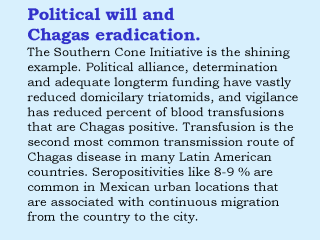 |
Southern Cone Initiative is a
joint agreement signed in 1991 between 7 governments of Argentina, Bolivia, Brazil, Chile,
Paraguay, Uruguay, and later Peru, to control Chagas disease by the elimination of the
main vector, domestic T. infestans, included the idea of suppressing or controlling
populations of other species that might be of local importance. The second objective was
to reduce the risk of Chagas disease transmission by blood transfusion. A preliminary analysis of likely costs and benefits of the Southern
Cone program predicted that total costs over a 10 year period (1991-2000) would be between
US $190 and 350 million, but against this direct benefits from savings in medical costs
alone would sum to around US $53 million per year with an estimated annual rate of return
on investment of just over 14%. In 1991-2001, the combined investment of the 7 governments
is estimated at just over US $320 million. Point studies that include benefits from
reduced morbidity as well as savings in medical costs, indicate actual rates of financial
return of around 30% in Brazil and over 64% in Argentina. Brazil invested about US $420
million in Chagas disease control with consequent benefits of well over US$ 3 billion—a
return of US $ 7.16 for every dollar invested. Malaria, schistosomiasis, leishmaniasis,
filariasis, onchocercosis and leprosy produce all together a health burden corresponding
to less than 25 % of that caused by Chagas disease. |
